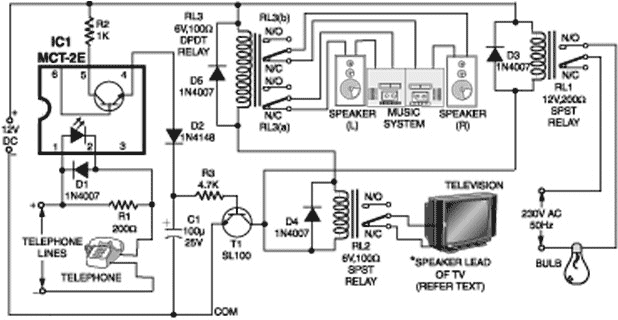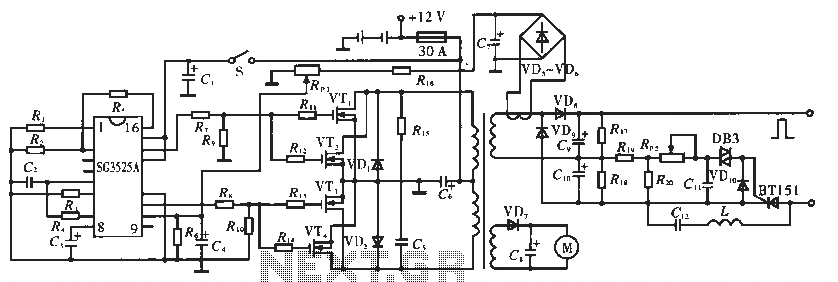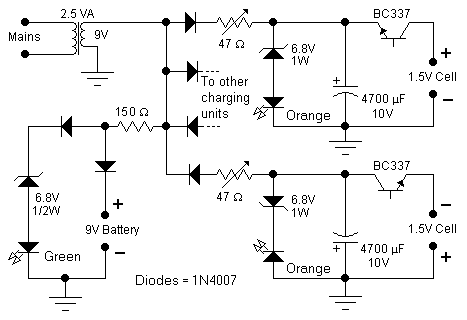
Telephone line based audio muting and light on circuit

A telephone line-based audio muting and light activation circuit. Frequently, when listening to music or watching television at elevated volume levels, it becomes difficult to hear a telephone ring, resulting in missed important calls.
This circuit is designed to address the issue of missing phone calls due to high audio levels from other media sources. It operates by monitoring the telephone line for incoming calls while simultaneously controlling the audio output from a connected device, such as a television or stereo system.
The core component of the circuit is a telephone line interface that detects the ringing signal. This is typically accomplished using a transformer or an opto-isolator to ensure electrical isolation from the telephone line. When a call is detected, the circuit activates a relay or a transistor switch that mutes the audio output of the connected device.
In addition to muting the audio, the circuit can also activate a visual indicator, such as an LED, to provide a visual cue of an incoming call. This LED can be connected in parallel with the relay or transistor switch, illuminating when the circuit is triggered.
Power for the circuit can be derived from the telephone line itself, which allows it to operate independently of external power sources. The design should include necessary protection components, such as diodes, to prevent damage from voltage spikes or reverse polarity situations.
The integration of this circuit into existing audio systems enhances user convenience by ensuring that important calls are not missed, even in noisy environments. Proper layout and component selection are crucial to ensure reliable operation and minimal interference with the audio signal.
Overall, this telephone line-based audio muting and light activation circuit serves as an effective solution for managing audio levels in the presence of incoming phone calls.Telephone line based audio muting and light on circuit. Very often when enjoying music or watching TV at high audio level, we may not be able to hear a telephone ring and thus miss an important incoming phone. 🔗 External reference
This circuit is designed to address the issue of missing phone calls due to high audio levels from other media sources. It operates by monitoring the telephone line for incoming calls while simultaneously controlling the audio output from a connected device, such as a television or stereo system.
The core component of the circuit is a telephone line interface that detects the ringing signal. This is typically accomplished using a transformer or an opto-isolator to ensure electrical isolation from the telephone line. When a call is detected, the circuit activates a relay or a transistor switch that mutes the audio output of the connected device.
In addition to muting the audio, the circuit can also activate a visual indicator, such as an LED, to provide a visual cue of an incoming call. This LED can be connected in parallel with the relay or transistor switch, illuminating when the circuit is triggered.
Power for the circuit can be derived from the telephone line itself, which allows it to operate independently of external power sources. The design should include necessary protection components, such as diodes, to prevent damage from voltage spikes or reverse polarity situations.
The integration of this circuit into existing audio systems enhances user convenience by ensuring that important calls are not missed, even in noisy environments. Proper layout and component selection are crucial to ensure reliable operation and minimal interference with the audio signal.
Overall, this telephone line-based audio muting and light activation circuit serves as an effective solution for managing audio levels in the presence of incoming phone calls.Telephone line based audio muting and light on circuit. Very often when enjoying music or watching TV at high audio level, we may not be able to hear a telephone ring and thus miss an important incoming phone. 🔗 External reference
Warning: include(partials/cookie-banner.php): Failed to open stream: Permission denied in /var/www/html/nextgr/view-circuit.php on line 713
Warning: include(): Failed opening 'partials/cookie-banner.php' for inclusion (include_path='.:/usr/share/php') in /var/www/html/nextgr/view-circuit.php on line 713





